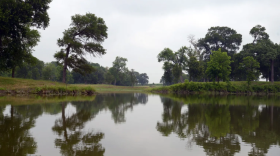-
Historically, Black bears were the biggest predator to travel the Big Bend area of Texas. But overhunting and habitat loss led to their decline.
-
Cottonseeds could help reduce hunger and add new revenue for farmers. One researcher has been working for decades to make edible seeds a reality.
-
The proposed project that would install 43 high-capacity wells drew the ire of East Texans, worried their wells would run dry.
-
The U.S. agricultural industry depends on undocumented immigrants, but President Trump's immigration crackdown is further depleting an already tight workforce. The labor crisis may be setting the stage for big changes to a federal program that allows foreign workers into the country legally.
-
Texas voters approved billions to help the state address water supply needs, but Tarrant County-area leaders concede more resources are needed to keep up with growth.
-
Food bank staff expect a wave of new demand as millions of Americans are set to lose federal food assistance in November. But they insist that their services alone won't be enough to feed everyone who relies on the Supplemental Nutrition Assistance Program.
-
Florida-based Marathon Digital Holdings claims Mitchell Bend's vote to incorporate as Texas' newest city is "unlawful."
-
Border walls and new surveillance technology could be coming to the greater Big Bend region and the rest of Texas’ southern border as part of a sweeping “Smart Wall” plan announced by the Trump administration this month.
-
How tech companies and government officials handle local impacts will shape the industry's future in the U.S.
-
An energy giant is set to break ground for a data center project across about 430 acres in southeast Fort Worth amid concerns about noise pollution and declining value of nearby homes and businesses.
-
Bird experts say the Kay Bailey Hutchison Convention Center is one of the deadliest buildings in Dallas for birds. Advocates want the redesign to be more bird-friendly.
-
Musk said his proposal to build tunnels to address Houston's chronic flooding woes would work, after an investigation raised questions about the plan's effectiveness. But experts say his plan has key technical and logistical challenges.
-
North Texas has seen 26 days this year when ozone exceeded the federal limit of 70 parts per billion.
-
A new analysis found heavily urbanized areas of Dallas are 14 degrees hotter due to the heat island effect. Dallas planners say limiting the use of pavement could help combat the heat.

















